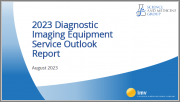
|
시장보고서
상품코드
1341043
영상 진단 장비 서비스 전망(2023년)2023 Diagnostic Imaging Equipment Service Outlook |
||||||
미국의 병원은 영상 진단 장비의 자본비용과 운영 비용을 정밀 조사하고 있습니다. 수입원이 계속 압박받는 가운데 장비 정비, 수리, 부가가치 서비스에 대한 보상은 예산 결정에서 계속해서 중요한 고려사항이 되고 있습니다. 영상 진단 장비의 사용과 도입이 계속 확대하는 가운데 병원 및 헬스케어 시스템은 운영 비용을 삭감하고, 지원 서비스의 가치를 향상시키기 위해 영상 진단 시설 전체에서 보증 후 서비스 계약을 통합하고, 표준화하려 하고 있습니다.
미국의 병원이 11개의 주요 영상 진단 장비에 대해 이용하고 있는 보증 후 서비스 계약의 유형에 대해 조사하고 있습니다. 영상 진단 장비 제조업체(OEM) 대 서드파티 서비스 프로바이더의 시장 점유율을 정량화하고, 모달리티별로 다른 유형의 서비스 계약 방식의 이용 상황, 선호되는 지원 서비스의 유형을 설명하고, 향후 서비스 계약과 선호되는 계약 유형에 대한 우선순위의 동향 등을 정리하여 전해드립니다.
목차
제1장 배경과 목적
제2장 주요 요약
제3장 조사 방법
제4장 영상 장비 관리시 부문의 우선사항
제5장 미국의 병원별 영상 장비 서비스 지출
제6장 보증 후 서비스에 사용되는 서비스 프로바이더
제7장 모달리티별 서비스 계약의 현재 사용 상황
제8장 모달리티별 "멀티 OEM" 서비스 계약의 현재 사용 상황
제9장 모달리티별 향후 서비스 계약의 선호 방식
제10장 영상 서비스 계약 우선순위
제11장 서비스 계약의 의사결정자
제12장 조사 응답자 인구통계
제13장 부록
KSA 23.09.11U.S. hospitals have been closely scrutinizing their capital and operating costs for imaging equipment. With continued pressure on their revenue sources, coverage for equipment maintenance, repair, and value-added services continue to be critical considerations in such budgetary decisions. As their use and deployment of imaging equipment continues to grow, hospitals and healthcare systems are seeking to consolidate and standardize their post-warranty service contracts across their imaging locations to decrease their operating costs, while gaining improved value for the support services they receive.
IMV's “2023 Diagnostic Imaging Equipment Service Outlook Report ” provides insight into the types of post-warranty service arrangements used by U.S. hospitals for eleven key imaging modalities. This report quantifies the market shares of the imaging equipment manufacturers (OEMs) vs. third-party service providers, describes the use of different types of service contract arrangements by modality, the types of support services preferred, and identifies trends in priorities for future service contracts and preferred contract types.
Major imaging modalities covered in this report:
- CT scanners
- Fixed MRI scanners
- Fixed PET or PET/CT
- Fixed Nuclear Medicine cameras (SPECT/CT, SPECT-only, and planar-only units)
- Fixed C-arm systems used primarily for interventional and/or cardiac procedures (e.g., specials, angio labs, vascular labs, cath labs, hybrid OR)
- Portable C-arm units
- Fixed Radiographic Fluoroscopy (RF) units (without fixed C-arms)
- Fixed General X-ray Radiography units (DR, CR, or analog)
- Mobile general x-ray units
- X-ray mammography units
- Ultrasound units
Questions answered by this report:
- What are the key department priorities for managing imaging equipment over the next few years?
- What is the estimated market size of hospital service-related spending?
- How is this market split between contracts with OEMs vs. third-party service providers, as well as service purchased outside of contract coverage?
- What % of service budgets are spent by modality, including CT, MR, PET, NM, fixed & portable C-arms, RF, general x-ray, mammography, and ultrasound?
- What type of post-warranty service arrangements is preferred for each imaging modality, including full- service, shared-service, and multi-vendor contracts?
- What mix of OEM vs. third-party service providers are currently being utilized for each imaging modality?
- To what extent do existing service arrangements include value-added features such as on-site response time, remote diagnostics, and cybersecurity services?
- What types of service contract issues are priorities for hospitals to address over the next few years?
- What will be the preferred coverage types and support services for inclusion in future service contracts?
- Who are the key decision makers for service contract arrangements?
Table of Contents
- 01. Background and Objectives
- 02. Executive Summary
- 03. Methodology
- 04. Department Priorities when Managing Imaging Equipment
- 05. Imaging Equipment Service Spending by U.S. Hospitals
- 06. Service Providers used for Post-Warranty Service
- 07. Present use of Service Arrangements, by Modality
- 08. Present use of "Multi-OEM" Service Contracts, by Modality
- 09. Preferred Arrangements for Future Service Contracts, by Modality
- 10. Imaging Service Contract Priorities
- 11. Decision Makers for Service Contracts
- 12. Survey Respondent Demographics
- 13. Appendix



















